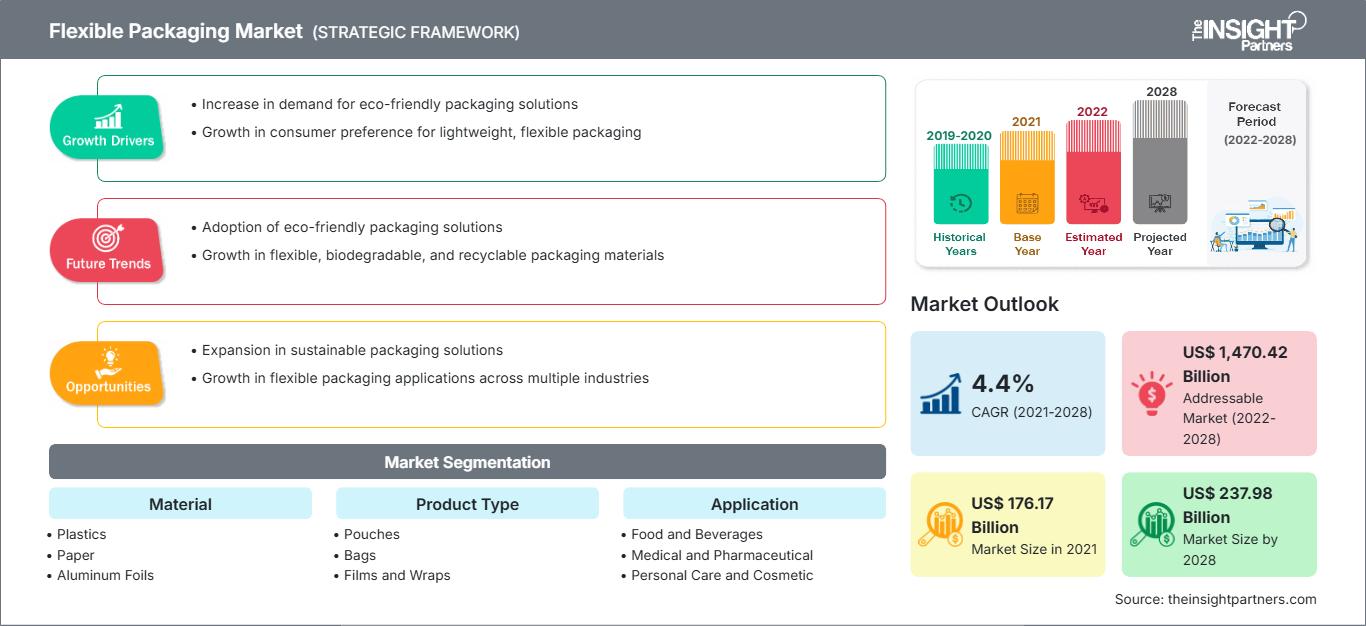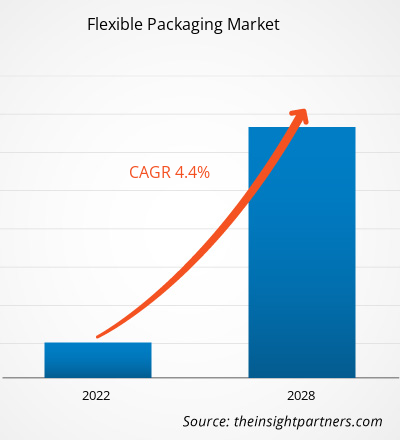Flexible Packaging Market Dynamics and Developments by 2028
Historic Data: 2019-2020 | Base Year: 2021 | Forecast Period: 2022-2028Flexible Packaging Market Forecast to 2028 - COVID-19 Impact and Global Analysis By Material (Plastics, Paper, Aluminum Foils, and Others), Product Type (Pouches, Bags, Films and Wraps, and Others), and Application (Food and Beverages, Medical and Pharmaceutical, Personal Care and Cosmetic, Industrial, and Others)
- Report Date : Jan 2022
- Report Code : TIPRE00004515
- Category : Chemicals and Materials
- Status : Published
- Available Report Formats :


- No. of Pages : 154
The flexible packaging market is projected to reach US$ 237,975.67 million by 2028 from US$ 176,173.61 million in 2021; it is expected to grow at a CAGR of 4.4% from 2021 to 2028.
Flexible packaging includes liners, pouches, seals, sample packets, and bags. It can be composed of film, plastic, paper, foil, etc. It is used for various food and beverage items, consumer products, music CDs, pharmaceuticals, computer software packages, and nutraceuticals. The durability offered by flexible packaging allows manufacturers to print eye-catching and high-quality custom designs, which increase product visibility in a retail setting.
In 2020, Asia Pacific held the largest revenue share of the global flexible packaging market. According to Asia-Pacific Economic Cooperation, Australia is one of the developed countries in APAC. The food & beverage sector is Australia’s largest manufacturing industry, accounting for 32% of the country’s total manufacturing turnover. According to the Australian Food and Grocery Council’s 2019 State of the Industry Report, the food & beverage, grocery, and fresh produce sector is worth USD$ 85.32 billion. The industry is made up of 15,000 businesses of all sizes that employ over 273,000 people. The growing food & beverage industry drives the flexible packaging market.
Customize This Report To Suit Your Requirement
You will get customization on any report - free of charge - including parts of this report, or country-level analysis, Excel Data pack, as well as avail great offers and discounts for start-ups & universities
Flexible Packaging Market: Strategic Insights

-
Get Top Key Market Trends of this report.This FREE sample will include data analysis, ranging from market trends to estimates and forecasts.
Impact of COVID-19 Pandemic on Flexible Packaging Market
The shutdown of manufacturing units, difficulty in the procurement of raw materials, restriction on logistics has had a negative impact on the flexible packaging market. However, COVID-19 created massive spikes in online grocery delivery. In addition, packaged food and beverage industries are witnessing an upsurge in demand for shelf-stable foods and beverages, including milk products, as consumers rush to stock the pantries. Millions of households started buying groceries online for pickup or home delivery, and many will continue using e-commerce options after the crisis passes. Furthermore, the increasing demand for processed food products such as convenience-oriented foods that generally use high-barrier, premium packaging materials for higher shelf life is poised to encourage the need for flexible packaging.
Market Insights
Increased Consumption of Processed Food & Beverage
According to Anu Food Brazil report, the Brazilian food retail sector’s total revenue was US$ 96 billion in 2019. The food & beverage industry in Brazil achieved growth of 6.7% in 2019 and 12.8% in 2020. The frozen food market is prospering in Brazil. The frozen food market is prospering in Brazil due to the expansion of the middle class, rise in purchasing power, and an increase in the number of people working full time. Hence, the increasing consumer preference toward convenience foods drives the flexible packaging market.
Material Industry Insights
Based on material, the global flexible packaging market is segmented into plastics, paper, aluminum foils, others. The plastics segment held the largest share of the global flexible packaging market in 2020. Flexible plastic packaging involves various types of plastic material used for the packaging of different products. The type of material used in packaging depends upon the application and type of product to be packaged. Generally, plastic materials, such as polyethylene, polypropylene, polystyrene, and polyvinyl chloride, are used in flexible plastic packaging. Flexible packaging is considered the most convenient and economical way to preserve, distribute and package food items, beverages, pharmaceutical products and several consumables.
A few of the key players operating in the global flexible packaging market include Amcor plc, Huhtamaki, Mondi, Berry Global Inc., Sealed Air, Sonoco Products Company, Coveris, Constantia Flexibles, Flexpak services, and Transcontinental Inc. Players operating in the market are highly focused on the development of high-quality and innovative product offerings to fulfill the customer’s requirements.
Flexible Packaging Market Regional Insights
The regional trends and factors influencing the Flexible Packaging Market throughout the forecast period have been thoroughly explained by the analysts at The Insight Partners. This section also discusses Flexible Packaging Market segments and geography across North America, Europe, Asia Pacific, Middle East and Africa, and South and Central America.
Flexible Packaging Market Report Scope
| Report Attribute | Details |
|---|---|
| Market size in 2021 | US$ 176.17 Billion |
| Market Size by 2028 | US$ 237.98 Billion |
| Global CAGR (2021 - 2028) | 4.4% |
| Historical Data | 2019-2020 |
| Forecast period | 2022-2028 |
| Segments Covered |
By Material
|
| Regions and Countries Covered |
North America
|
| Market leaders and key company profiles |
|
Flexible Packaging Market Players Density: Understanding Its Impact on Business Dynamics
The Flexible Packaging Market is growing rapidly, driven by increasing end-user demand due to factors such as evolving consumer preferences, technological advancements, and greater awareness of the product's benefits. As demand rises, businesses are expanding their offerings, innovating to meet consumer needs, and capitalizing on emerging trends, which further fuels market growth.

- Get the Flexible Packaging Market top key players overview
Report Spotlights
- Progressive trends in the flexible packaging industry to help players develop effective long-term strategies
- Business growth strategies adopted by the market players in developed and developing countries
- Quantitative analysis of the flexible packaging market from 2019 to 2028
- Estimation of global demand for flexible packaging
- Porter’s Five Forces analysis to illustrate the efficacy of buyers and suppliers operating in the industry
- Recent developments to understand the competitive market scenario
- Market trends and outlook as well as factors driving and restraining the growth of the flexible packaging market
- Assistance in the decision-making process by highlighting market strategies that underpin commercial interest, leading to the market growth
- The size of the flexible packaging market at various nodes
- Detailed overview and segmentation of the market, as well as the industry dynamics
- Size of the flexible packaging market in various regions with promising growth opportunities
Frequently Asked Questions
Can you list some of the major players operating in the global flexible packaging market?
In 2020, which region held the largest share of the global flexible packaging market?
Which material segment accounted for the largest share in the global flexible packaging market?
Which product type segment accounted for the largest share in the global flexible packaging market?
Which region is the fastest growing in the global flexible packaging market?
Which application segment accounted for the largest share in the global flexible packaging market?
Habi is a seasoned Market Research Analyst with 8 years of experience specializing in the Chemicals and Materials sector, with additional expertise in the Food & Beverages and Consumer Goods industries. He is a Chemical Engineer from Vishwakarma Institute of Technology (VIT) and has developed deep domain knowledge across industrial and specialty chemicals, paints and coatings, paper and packaging, lubricants, and consumer products. Habi’s core competencies include market sizing and forecasting, competitive benchmarking, trend analysis, client engagement, report writing, and team coordination—making him adept at delivering actionable insights and supporting strategic decision-making.
- Historical Analysis (2 Years), Base Year, Forecast (7 Years) with CAGR
- PEST and SWOT Analysis
- Market Size Value / Volume - Global, Regional, Country
- Industry and Competitive Landscape
- Excel Dataset
Recent Reports
Testimonials
The Insight Partners' SCADA System Market report is comprehensive, with valuable insights on current trends and future forecasts. The team was highly professional, responsive, and supportive throughout. We are very satisfied and highly recommend their services.
RAN KEDEM Partner, Reali Technologies LTDsI requested a report on a very specific software market and the team produced the report in a few days. The information was very relevant and well presented. I then requested some changes and additions to the report. The team was again very responsive and I got the final report in less than a week.
JEAN-HERVE JENN Chairman, Future AnalyticaWe worked with The Insight Partners for an important market study and forecast. They gave us clear insights into opportunities and risks, which helped shape our plans. Their research was easy to use and based on solid data. It helped us make smart, confident decisions. We highly recommend them.
PIYUSH NAGPAL Sr. Vice President, High Beam GlobalThe Insight Partners delivered insightful, well-structured market research with strong domain expertise. Their team was professional and responsive throughout. The user-friendly website made accessing industry reports seamless. We highly recommend them for reliable, high-quality research services
YUKIHIKO ADACHI CEO, Deep Blue, LLC.This is the first time I have purchased a market report from The Insight Partners.While I was unsure at first, I visited their web site and felt more comfortable to take the risk and purchase a market report.I am completely satisfied with the quality of the report and customer service. I had several questions and comments with the initial report, but after a couple of dialogs over email with their analyst I believe I have a report that I can use as input to our strategic planning process.Thank you so much for taking the extra time and making this a positive experience.I will definitely recommend your service to others and you will be my first call when we need further market data.
JOHN SUZUKI President and Chief Executive Officer, Board Director, BK TechnologiesI wish to appreciate your support and the professionalism you displayed in the course of attending to my request for information regarding to infectious disease IVD market in Nigeria. I appreciate your patience, your guidance, and the fact that you were willing to offer a discount, which eventually made it possible for us to close a deal. I look forward to engaging The Insight Partners in the future, all thanks to the impression you have created in me as a result of this first encounter.
DR CHIJIOKE ONYIA MANAGING DIRECTOR, PineCrest Healthcare Ltd.Reason to Buy
- Informed Decision-Making
- Understanding Market Dynamics
- Competitive Analysis
- Identifying Emerging Markets
- Customer Insights
- Market Forecasts
- Risk Mitigation
- Boosting Operational Efficiency
- Strategic Planning
- Investment Justification
- Tracking Industry Innovations
- Aligning with Regulatory Trends




















 Get Free Sample For
Get Free Sample For